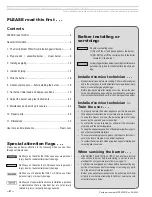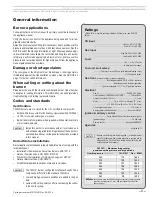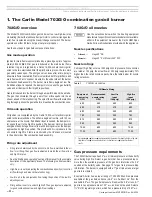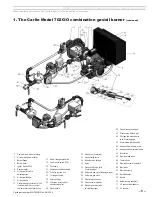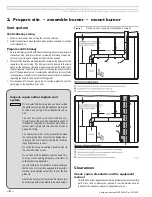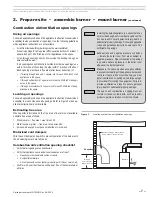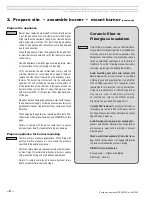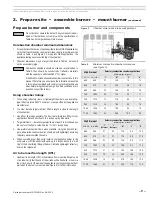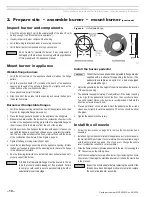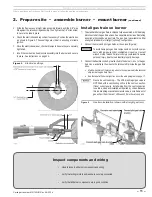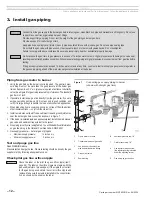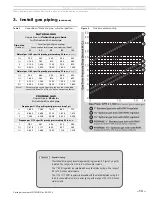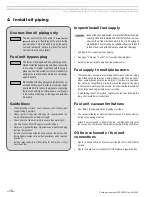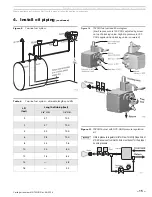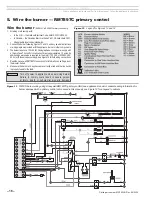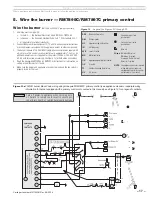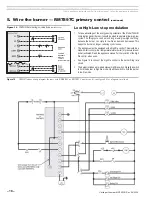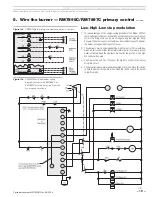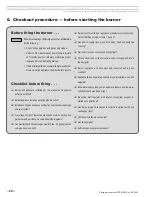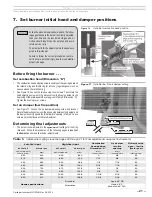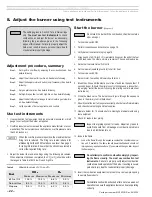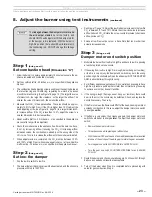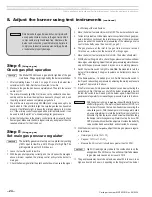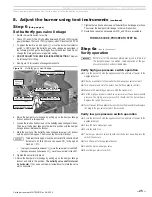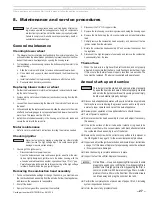
Model 702G/O Advanced gas/oil burners — Instruction manual
Carlin part number MN702GO Rev. 06/23/14
– 12 –
Where appliance instructions differ from this manual, follow the appliance instructions.
3. Install gas piping
Piping from gas meter to burner
1.
Verify the gas train on the burner is correctly sized. The gas train pres-
sure drop must not be more than the gas pressure at the burner gas
train entrance minus 3.4" w.c. (pressure required at entrance to butterfly
valve). See Figure 8 for gas train pressure drop information. The standard
gas train is 1 inch.
2.
If possible, install a new gas line directly from the gas meter. If you are
using an existing gas line, verify it is clean and in good condition, and
verify it is large enough to handle the load of all connected appliances.
3.
When branching from a common gas line, do not tap off from the bottom
of horizontal sections — only from the side or top.
4.
Install a main manual shutoff valve, sediment trap and ground joint union
near the burner gas train connection as shown in Figure 7.
5.
If the burner is installed inside an appliance jacket, install the main manual
gas valve and sediment trap external to the jacket.
6.
Size piping (or verify size) using Table 3. You will find additional information
on gas line sizing in the National Fuel Gas Code, ANSI Z223.1.
7.
Gas supply pressure —
natural gas or propane
•
Maximum supply pressure:
14 inches w.c.
•
Minimum supply pressure:
5 inches w.c.
Test and purge gas line
Read WARNING above.
Pressure test and purge the line. Pressure testing should be done by the gas
supplier or utility, following all applicable codes.
Check pilot gas line orifice nipple
Check the label on the pilot line gas orifice nipple (item 1,
page 29). The label on the orifice nipple must agree with the
gas used (natural or propane gas). If the nipple is not correct
for the gas being used, obtain the correct orifice nipple and
replace. Make sure the nipple is installed in the correct direc-
tion, as shown by the arrow on the label.
Figure 7
Connecting gas supply piping to burner
(shown with straight gas train)
1 Pipe to meter or branch
2 T-handle main manual gas valve
3 Use clean, burr-free black iron
pipe and malleable iron fittings
4 Ground joint union
5 Sediment leg
6 Upstream pressure tap, 1/4"
7 Outlet pressure tap, 1/4"
8 Gas regulator access screw
(the regulator spring is located
under the adjusting screw)
9 Gas train wire junction box
Connect from the gas supply to the burner gas train inlet using new, clean black iron pipe and malleable iron fittings only. Do not use
copper, brass, cast iron or galvanized pipe or fittings.
Provide support for gas piping. Do not rest the weight of the gas piping on burner gas train.
Provide a support for the burner gas train.
Apply pipe dope sparingly at all joints. Use only pipe dope listed for use with propane gas. Do not use pipe sealing tape.
Do not hold the gas valve with pipe wrench. Use crescent wrench or other smooth-jawed device. Do not overtighten.
Failure to comply with above could result in severe personal injury, death or substantial property damage.
Do not expose the gas train to gas pressure in excess of 14 inches water column. Higher pressure could damage the valve seat,
resulting in potentially hazardous condition. When pressure testing piping at higher pressures, disconnect burner from gas line before
testing.
If the gas supply pressure can exceed 14 inches water column at any time, you must install a lockup type gas pressure regulator in
the gas supply piping, ahead of the main manual gas valve installed at the burner.


